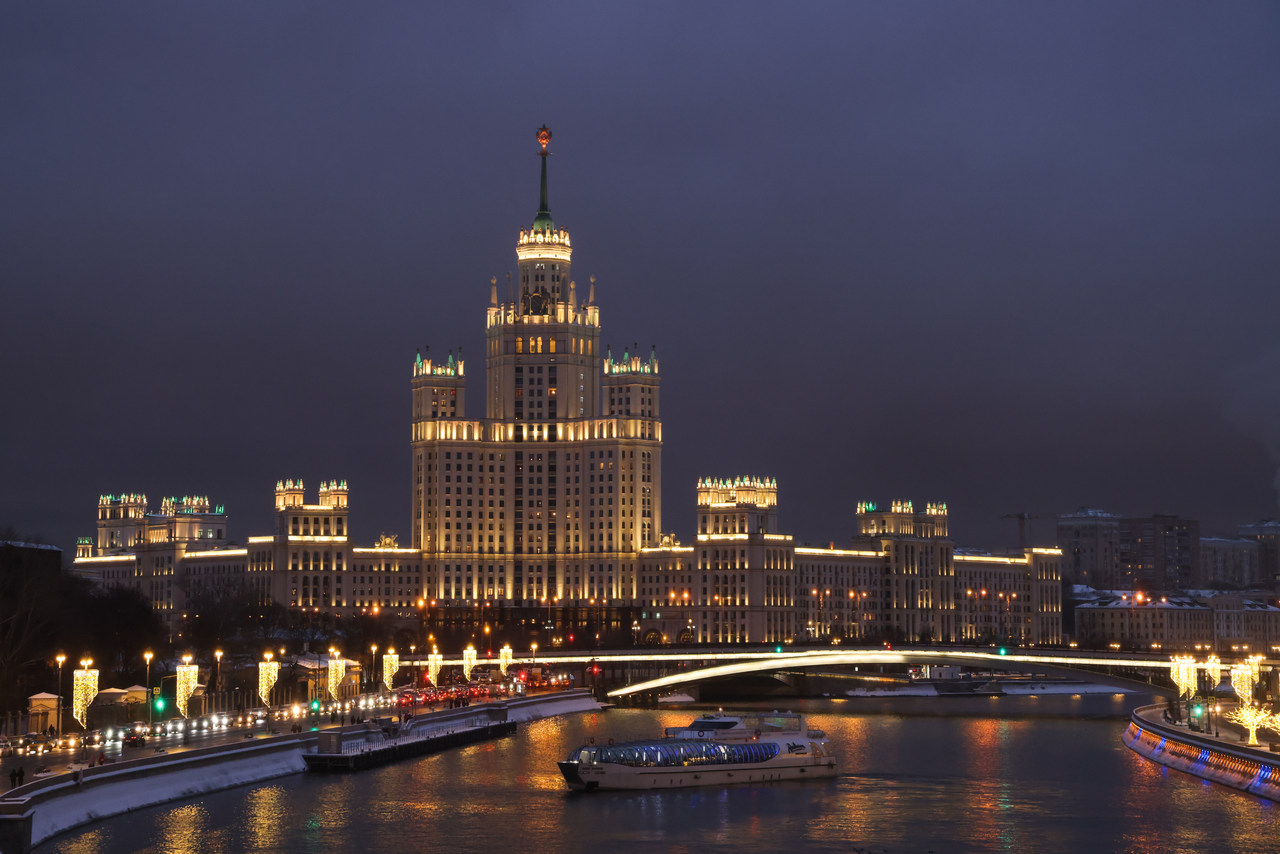Prospects for the Development of the "3+3" Format on the South Caucasus
On 10 December, the inaugural meeting of the “3+3” format was held in Moscow. The initiative is meant to be a new formula for regional cooperation and it includes Armenia, Azerbaijan, and Georgia, with Russia, Turkey, and Iran, although Georgia is boycotting it. The interests of the other countries in the format reflects deeper tendencies in their regional policy given the new status quo after the Nagorno-Karabakh war in 2020. The project is a manifestation of Russia, Turkey, and Iran’s desire to limit U.S. and EU influence in the South Caucasus. Georgia’s participation could be a key factor that determines the effectiveness of the format, which is why the U.S. and the EU should counteract the initiative by strengthening cooperation with Georgia.
 Fot.Stanislav Krasilnikov/TASS/FORUM
Fot.Stanislav Krasilnikov/TASS/FORUM
During a parade in Baku celebrating Azerbaijan’s victory in the Nagorno-Karabakh (NK) war, presidents Recep Tayyip Erdoğan of Turkey and Azerbaijan Ilham Aliyev of Azerbaijan proposed the creation of a South Caucasus-focused collaboration format called the “3+3”. It would include three countries in the region—Azerbaijan, Armenia and Georgia—and three powers neighbouring them that are involved in regional policy—Russia, Turkey and Iran. The “3+3” would be a non-institutionalised format for regional multilateral cooperation (modelled on the Astana Process on the civil war in Syria). Its stated goals go beyond maintaining stability and security in the South Caucasus and include the economic development of the region, for example, by unblocking transport corridors or joint infrastructure investments. The initiative refers to the idea of the “3+3+2” format put forward by Aliyev’s father and the former president of Azerbaijan, Heydar Aliyev, during the OSCE summit in Istanbul in 1999. The concept then, unlike today, included the U.S. and the EU.
Stakeholders and Their Different Interests
For the countries of the region, the “3+3” is an opportunity to expand their room for manoeuvre in foreign policy. Azerbaijan wants to take advantage of its victory in the NK in 2020 and the new, more favourable security situation in the South Caucasus. Its aim is to consolidate its alliance with Turkey and strengthen its regional position as leader. On the other hand, Armenia, which as a consequence of the “Russian truce” came under even greater military pressure from Azerbaijan and Turkey and felt its subordination to Russia deepen, now sees a chance to reduce its regional isolation through the “3+3”, especially given the state of war with Azerbaijan and lack of diplomatic relations and closed borders with Turkey. The Armenian authorities also hope that the development of the format will help it reduce the border tensions with Azerbaijan and normalise relations with Turkey. Georgia is the only country in the region to boycott the new initiative. Georgian Foreign Minister David Zalkaliani proposed an alternative that includes only the three countries of the region—it with Armenia and Azerbaijan. Despite this, Georgia does not definitively exclude its participation in the “3+3”, as the authorities do not want to antagonise Turkey or Azerbaijan and see the possibility in the new format for normalising relations with Russia by transferring them to the multilateral level.
For Russia, Turkey, and Iran, the “3+3” is to be an instrument to secure their interests in the South Caucasus and limit what they see as interference by other actors, namely the U.S. and the EU. However, each of these three countries wants to be seen as the leader of the initiative. Russia and Turkey also see the new format as an additional instrument for the development of cooperation with Iran and the coordination of policies both in the South Caucasus and in the Middle East. The “3+3” gives Russia the chance to increase its capacity to instrumentalise regional conflicts, not only the one between Armenia and Azerbaijan but also the tensions in Turkish-Iranian and Azerbaijani-Iranian relations. Russia will use the format to position itself as a mediator in the conflicts between the format’s members, and in turn force them to make decisions favourable from Russia’s perspective. For Turkey, the “3+3” allows it to present itself as a country that is stabilising its neighbourhood, strengthening its international position. Turkey’s influence in the South Caucasus is based primarily on its alliance with Azerbaijan, so it views participation in a broader regional cooperation structure as helping it to consolidate and expand its influence in the region. Iran sees participation in the “3+3” is an opportunity to improve its position in the region, marginalised as a result of the conflict over the NK in 2020. Moreover, Iran sees in the format an instrument to limit U.S. and EU influence in its northern neighbourhood and, following the experience of the Astana Process, counts on reducing its international isolation by intensifying cooperation with Russia and Turkey.
Challenges for Cooperation
The divergence of interests of the countries involved in the “3+3” limits the potential development of this format. Contrary to the declarations, it will not become a platform for resolving conflicts and problems in the region, rather it will only strengthen Russia, Turkey, and Iran’s control over the foreign policy course of the three smaller regional countries. In addition, the multilateral diplomacy format will have a weak impact on the security situation in a region where, since 2020, Russia and Turkey have been protecting their interests with their militaries. Another limitation for effective “3+3” cooperation is the nationalist tendencies in Turkey and Azerbaijan (anti-Armenian and anti-Iranian) and in Armenia (anti-Azeri and anti-Turkish), which hinders real cooperation.
Another obvious challenge is Georgia’s boycott, which strikes at the “founding idea” of the “3+3” as a format to strengthen cooperation between all countries in the region. The Georgian authorities believe that the formula of cooperation with Russia, Turkey, and Iran is incompatible with the pro-Western course in Georgian foreign policy. In addition, the decision to participate in the format at this point could strengthen anti-government sentiment in Georgian society as the vast majority (around 90%) opposes cooperation with Russia, which occupies the separatist republics of Abkhazia and South Ossetia.
Conclusions and Perspectives
The “3+3” will likely become an important forum for consultation between the participants, but in terms of propaganda. Its influence on the situation in the region will be limited by the divergent interests of its members. Additionally, the legitimacy of this new format will be adversely affected by the Georgian boycott.
The interests of the countries in the region in this kind of cooperation signals, however, deeper tendencies in regional policy after the war in the NK in 2020 and which are unfavourable for the EU and the U.S. They stem from a feeling of discouragement in countries of the region (particularly in Armenia and Azerbaijan) as a result of the ineffectiveness of the EU and U.S. to resolve the war in the NK last year, which ultimately was decided by Russian and Turkish forces without the participation of EU Member States or the U.S.
Russia, Turkey, and Iran are benefiting from this, as they want to demonstrate their leadership and agency in the region. These three countries see weakness in EU and U.S. policies in the South Caucasus and want to take advantage of a moment they see as favourable to further reduce European Union and American influence in this region of the world (e.g., following the model of the Shanghai Cooperation Organisation in Central Asia). It is therefore very likely that they will seek to use the “3+3” to try to legitimise their future plans for the South Caucasus.
The idea behind the “3+3” and the related tendencies favouring this format threaten the U.S. and EU positions on the South Caucasus, with Georgia remaining the last pillar and the only one state that maintains pro-Atlantic and pro-European policy. They lay bare their loss of influence in recent years (especially in comparison with the call for the “3+3+2” formula of 1999 in which the U.S. and the EU were to be an integral part) and this will lead to their further marginalisation. In this situation, Georgia’s participation in the “3+3” could be the factor that determines the effectiveness and legitimacy of this format, which assumes the participation of all the countries in the region. Although Georgia is reluctant to join for now, it will continue to come under more military pressure from Russia and stronger economic pressure from Turkey and Azerbaijan to reassess its position on the initiative. In time, Georgia may decide to participate in the “3+3”, especially if it perceives a lack of U.S. and EU support.
If the U.S. and the EU want to counteract such negative trends in the South Caucasus, they could help Georgia maintain its scepticism of the “3+3” and keep it on its pro-European foreign policy course through a new, enhanced offer of economic cooperation, along with trying to strengthen the political mandate of the EU Monitoring Mission in Georgia (EUMM) and becoming more involved in de-escalating the domestic political conflict, which impacts relations between the Georgian authorities and the EU.


